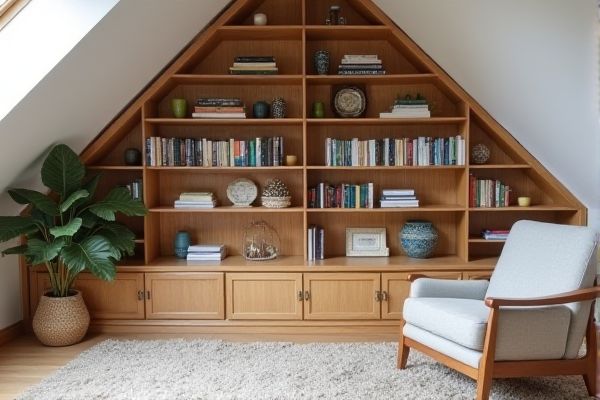
Built-in bookcases provide a seamless, customized look that maximizes attic space and adds structural value, while freestanding shelves offer flexibility and easy reconfiguration without permanent installation. Explore the rest of this article to determine which storage solution best suits your attic needs and personal style.
Table of Comparison
| Feature | Built-in Bookcase | Freestanding Shelf (Attic) |
|---|---|---|
| Installation | Permanent, requires construction | Portable, no installation needed |
| Space Utilization | Maximizes wall space efficiently | Requires floor space, less efficient |
| Customization | Highly customizable to room dimensions | Limited customization options |
| Durability | Sturdy, integrated with wall structure | Less sturdy, prone to movement |
| Cost | Higher upfront cost due to labor/materials | Lower cost, ready-made options available |
| Maintenance | Low maintenance when installed properly | Requires occasional repositioning and cleaning |
| Design Impact | Sleek, seamless integration with decor | More visible, can clutter attic space |
Introduction to Attic Storage Solutions
Attic storage solutions include built-in bookcases and freestanding shelves, each offering unique benefits tailored to space optimization and accessibility. Built-in bookcases maximize wall space by integrating storage seamlessly into attic architecture, ideal for customized organization and maintaining aesthetics. Freestanding shelves provide flexibility and mobility, allowing for easy rearrangement and adaptation to varying storage needs in the often irregular attic environment.
Built-In Bookcase: Definition and Features
A built-in bookcase is a custom-designed storage unit permanently integrated into your attic's wall structure, maximizing space efficiency and offering a seamless, tailored look. These bookcases are typically constructed from durable materials like wood or MDF, featuring adjustable shelves, crown molding, and can be painted to match the surrounding decor. Unlike freestanding shelves, built-ins provide stability and enhance property value by creating a cohesive architectural element in your attic space.
Freestanding Shelf: Definition and Features
A freestanding shelf is a movable storage unit designed to stand independently without attachment to walls or structures, making it ideal for attic spaces where flexibility is needed. These shelves often feature adjustable heights, open or closed storage options, and durable materials like wood or metal to support various items. Unlike built-in bookcases, freestanding shelves can be easily relocated or reconfigured, accommodating changing storage needs in confined or irregular attic areas.
Space Utilization in Attic Rooms
Built-in bookcases maximize space utilization in attic rooms by conforming to irregular walls and sloped ceilings, offering custom storage that fits seamlessly into tight or awkward nooks. Freestanding shelves, while flexible and easy to rearrange, often consume more floor area and may not fully capitalize on available vertical or corner space. Your attic's unique dimensions typically benefit more from tailored built-in solutions that optimize every inch for efficient storage.
Aesthetic Impact: Built-In vs Freestanding
Built-in bookcases create a seamless, integrated look that enhances your attic's architectural character and can increase the home's value by adding custom, permanent storage solutions. Freestanding shelves offer flexible placement and style options but may appear less cohesive, potentially disrupting the attic's visual flow. Choosing built-in units ensures a tailored fit and refined aesthetic impact that complements your attic space.
Cost Comparison and Budget Considerations
Built-in bookcases in attics typically involve higher costs due to custom design, materials, and professional installation, often ranging from $800 to $2,500 per linear foot. Freestanding shelves present a more budget-friendly option, with prices varying between $50 and $400 per unit depending on size and material, making them accessible for quick attic storage solutions. Evaluating long-term value, built-ins can increase home resale value through tailored functionality, while freestanding shelves offer flexibility and lower upfront investment.
Installation Process: DIY or Professional Help
Built-in bookcases require precise measurements and structural modifications, often necessitating professional carpentry to ensure proper alignment, stability, and finishing. Freestanding shelves offer a more straightforward installation process, allowing for easier DIY assembly with minimal tools and no permanent alterations to your attic space. Your choice depends on your skill level and willingness to commit time, as built-ins provide a custom, integrated look while freestanding options prioritize flexibility and ease.
Flexibility and Future Modifications
Freestanding shelves in your attic offer greater flexibility by allowing easy relocation and reconfiguration to suit changing storage needs or room layouts. Built-in bookcases provide a permanent, custom-fit solution that maximizes space efficiency but limit future modifications or adaptability. Choosing between the two depends on whether you prioritize adaptability with freestanding units or a fixed, seamless design with built-in options.
Durability and Maintenance Needs
Built-in bookcases offer superior durability due to their secure attachment to walls and solid construction, making them less prone to tipping or damage in your attic space. Freestanding shelves provide easier flexibility and relocation but often require regular maintenance to prevent wobbling and wear from movement or environmental factors. Choosing built-in units reduces long-term upkeep efforts, ensuring a sturdy, lasting storage solution ideal for attic use.
Choosing the Best Option for Your Attic
Built-in bookcases maximize attic space by fitting seamlessly into walls, providing a custom, permanent storage solution that enhances your home's value. Freestanding shelves offer flexibility, allowing you to rearrange or remove units without structural changes, ideal for varying storage needs in an attic. Consider your attic's layout, desired permanence, and flexibility to determine whether built-in bookcases or freestanding shelves best suit your storage and aesthetic goals.
 homyna.com
homyna.com